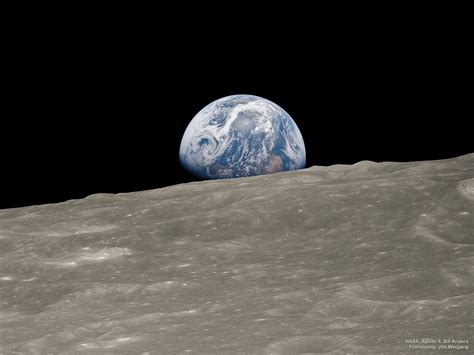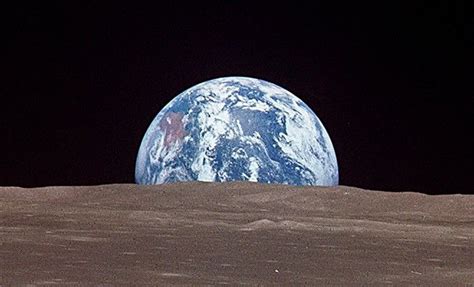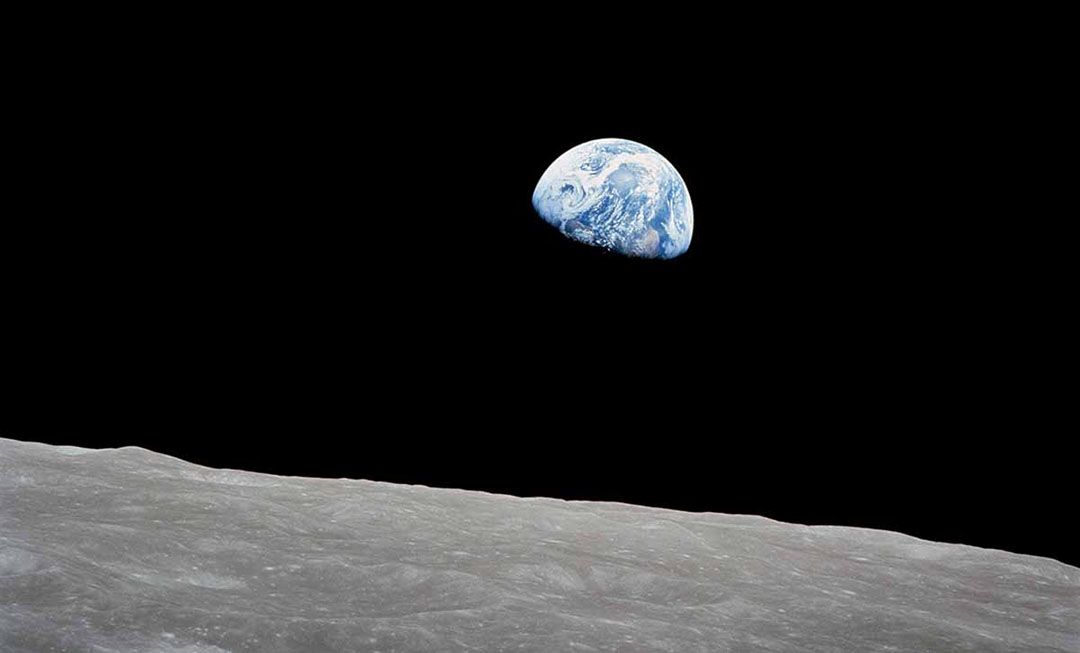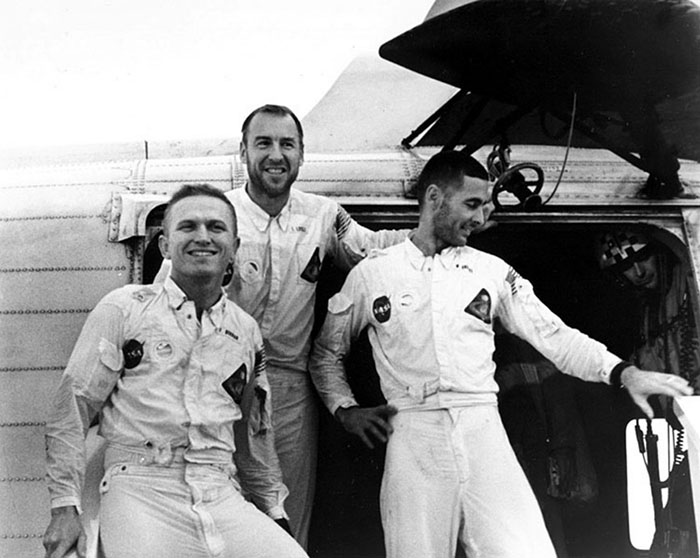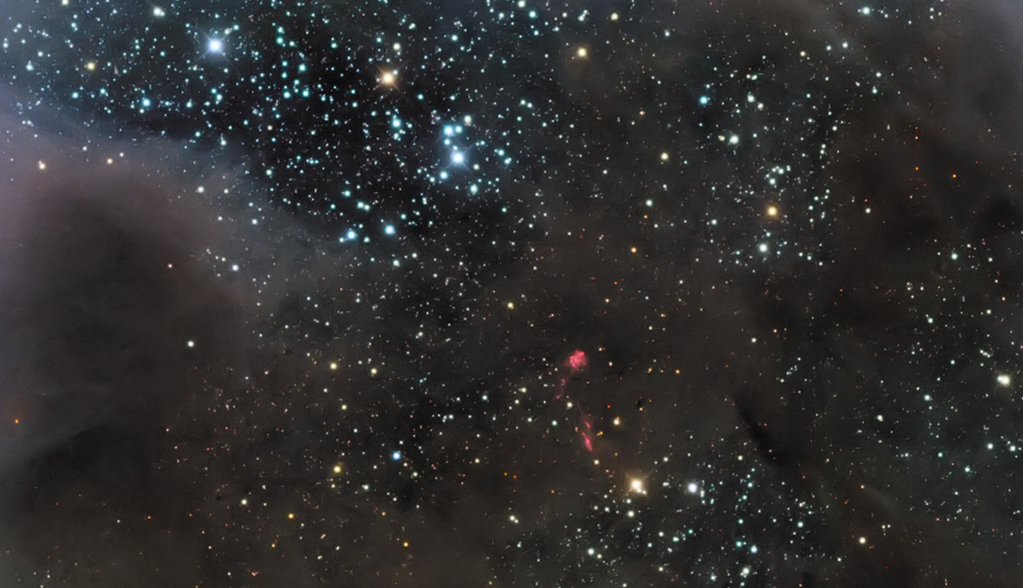|
Word Gems
exploring self-realization, sacred personhood, and full humanity
Soulmate, Myself:
The Wedding Song
an Earthrise restatement
return to "contents" page
|
"Earthrise"
NASA: "Apollo 8, the first manned mission to the Moon, entered lunar orbit on Christmas Eve, December 24, 1968. That evening, the astronauts - Commander Frank Borman, Command Module Pilot Jim Lovell, and Lunar Module Pilot William Anders - held a live broadcast from lunar orbit, in which they showed pictures of the Earth and Moon as seen from their spacecraft. Said Lovell, 'The vast loneliness is awe-inspiring and it makes you realize just what you have back there on Earth.' They ended the broadcast with the crew taking turns reading from the book of Genesis."
|
“Earthrise” has been called “the most influential photo ever taken.”
Perceiving something in its totality can offer jarringly new perspective to what we thought we knew.
So it is with my studies of The Wedding Song. Certain aspects of its meaning, I’ve found, can be appreciated only after the word-by-word analysis has been completed.
Let’s take an “Earthrise” view of it.
|
Editor's note:
Great literature discusses the important issues of life. Further, great literature, of which the channeled poetry of The Wedding Song is an example, will offer more than one meaning.
And some of this meaning resides in one's own deeper person. It’s brought to the surface of awareness almost with every reading, with each consideration of the important issues.
The following is one more exegesis of The Wedding Song.
|
I am now to be among you at the calling of your hearts
Rest assured this troubadour is acting on My part.
The union of your spirits, here, has caused Me to remain
For whenever two or more of you are gathered in My name
There am I, there is Love.
A man shall leave his mother and a woman leave her home
And they shall travel on to where the two shall be as one.
As it was in the beginning is now and til the end
Woman draws her life from man and gives it back again.
And there is Love, there is Love.
Well then what’s to be the reason for becoming man and wife?
Is it love that brings you here or love that brings you life?
And if loving is the answer, then who’s the giving for?
Do you believe in something that you’ve never seen before?
Oh there is Love, there is Love.
Oh the marriage of your spirits here has caused Me to remain
For whenever two or more of you are gathered in My name
There am I, there is Love.
Now that’s really interesting – Genesis 2:24 is the center of both The Wedding Song and the biblical creation story.
We couldn’t have known this without an “Earthrise” perspective. What does this double centering signify?
Editor’s note: It’s oddly coincidental that the Apollo 8 crewmen also referenced Genesis on that 1968 Christmas Eve.
Genesis 2:24, in its original biblical context, is a “cut, freeze-frame, stop the action” verse
We talked about this on the “verse two, part one” page of The Wedding Song, and you might want to refresh yourself on this.
However, to briefly recap:
Genesis 2:24: Therefore a man shall leave his father and
mother and be joined to his wife, and they shall become one
flesh. (NKJV)
Prior to Genesis 2:24, we’re offered a certain “what’s next?” narrative flow: we see Adam and the tree of the knowledge of good and evil, his naming of the animals, the death-trance, and the coming of Eve; and, before these items, we’re offered front-row seats to the creation of the universe and the world.
However, with verse 24 the sequential story-line is abruptly halted. How do we know this? According to the story, Adam had no “father and mother,” no parents for him to “leave” that he might be with Eve; therefore, with verse 24, we find a universal statement made to all humankind; more specifically, a message to all future Twin Souls.
The psychic-shaman author, with Genesis 2:24, virtually shouts, “cut,
freeze-frame,” and now, so to speak, walks out on center stage. Under a spotlight, he will address the audience directly. In effect, the message is this:
“Ladies and Gentlemen, thank you for your kind attention. I
must apologize for interrupting the Adam and Eve story, but
I thought you would want to know this. Everything that has
happened to this point, from Genesis 1:1 to 2:23, was meant
to prepare us for this moment, for something supremely important. I’d like you to think of it this way: the creation of the universe, the Earth, the animals, and especially the coming of Man and Woman, all focus upon a single purpose in the mind of God. All was designed that these Cosmic Two might travel on and adventure together, enter a process of becoming the super-intimate One Person, of becoming more and more like God, as they evolve toward their unlimited destiny and potential of having been ‘made in the image’.”
Walt Whitman: "The whole theory of the universe is directed to one individual... namely to You."
|
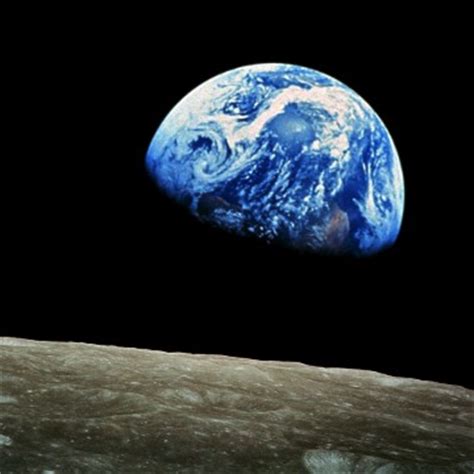
Editor's note:
Genesis 2:24, in its original biblical context, is an “Earthrise” verse. It takes us to a very high mountain, well beyond the ordinary, mythical narrative, and presents to us a pressingly real, non-temporal, universal principle for all humankind.
|
|
a second look at 'as it was in the beginning is now and til the end'
When I first began to study “The Wedding Song (TWS),” I assumed that this statement referred to an "arrow of time," a forward momentum with concrete start and finish: past, present, and future, toward some terminal event.
The mistake I made was forgetting that I was reading poetry.
The phrase “as it was in the beginning is now and til the end” is not meant to express mathematical precision; it’s not a rigorously defined precept of science. TWS is poetry, not didactic prose, and literary license becomes de rigueur fashion.
Why this reference to “the beginning” at all? It’s not vital to the overall message of TWS. But the reason should be clear. TWS is constructed around several allusions to biblical scripture; especially, the book of Genesis. “Beginning” is a very important term in the creation story – we see it in the very first verse of the Bible: “In the beginning” - and therefore TWS is inclined to reference this famous word and to frame its teaching within the well-known elements of Genesis.
And the expression “til the end” is also poetry. In other words, we should not look for mathematical or precisely-defined meaning in “til the end.” “End” usually means “end,” that is, some terminal point, finished, the curtain falls, done, over – but this is not the meaning of “end” in TWS.
When TWS employs “beginning” and “end,” it refers to an eternal process. Good things in the next dimensions do not come to an “end” but go on and on. Actually, the truly good things have no “beginning,” either. All virtues of God exist in a realm of timeless “singular pervasive reality.” There is nothing else. We discussed this in the plenary commentary of TWS.
Let’s notice the context in which the phrase is used:
A man shall leave his mother and a woman leave her home
And they shall travel on to where the two shall be as one.
As it was in the beginning is now and til the end
Woman draws her life from man and gives it back again.
And there is Love, there is Love.
TWS informs us that the process of Twins coming together in order to experience sacred oneness is part of a plan that has always lived in the mind of God. This ideal was there in God’s heart, right from the “beginning,” from the creation of universe.
TWS emphasizes process rather than a one-time event (see more discussion below). And when it speaks of “beginning,” “now,” and “til the end,” TWS means to put forward the concept, “it’s always been this way in the mind of God, and it’s also a present reality, and it’s never going to change.”
|
Genesis 2:24 presents the philosophical center of The Wedding Song
The Wedding Song offers it this way:
A man shall leave his mother and a woman leave her home
And they shall travel on to where the two shall be as one.
It is a culmination of the opening remarks of The Wedding Song's verse one, with subsequent lines of the poem debating and enhancing the meaning of this central theme.
In the Genesis creation story we find Eve coming alive, drawing her life from Adam; in reciprocity, she returns it to him.
The Genesis narrative suggests that Eve was imbued with biological life. But a different order of “life” is in view in the Song. There, lovers have left mother and father, purveyors of biological life, in favor of something more. The receipt of animal life is a “one and done” event, but The Wedding Song speaks of a form of life which arrives via process. We’ll discuss this much more below; however…
We are puzzled by the assertion of lovers “drawing life” from each other. We might have expected them to be “drawing love” or comfort, or pleasure, or happiness. This would have made sense to us.
What is this drawn “life”? In the plenary commentary we said it was a higher level of consciousness, and this is true. But what does higher level of consciousness mean for romantic lovers? And why is it called “life”?
A phrase from Aristotle comes to mind:
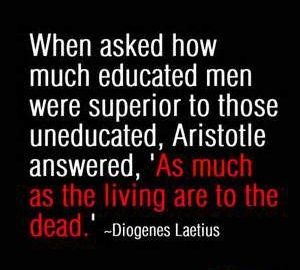
It could be said that this difference of death versus life also characterizes the common John-and-Mary love as opposed to that of eternal Twin Souls. Again, the “life” in view is not of the biological sort; one’s existence is not in question as we are creatures destined to live forever.
But this borderless longevity is not necessarily a blessing per se. In the writing, “Will You Survive the Terror of Eternal Life?” I posited that unless we come to know sacred meaning, purpose, and destiny, our lives will suffer attack by what I called “existential crisis.” The “500 tape-recorded messages from the other side” reveal an entire class of individuals over there, in their many millions, who are suffering in just this way.
The Wedding Song would have us know that the love experienced by Twin Souls is of such exquisite and empyreal quality that it’s “something never seen before,” and so the metaphor of “death versus life” is not an overstatement.
What is it like?
eclipsed by a larger sun
It’s more, much more, than a Niko-Tinbergen “supernormal stimulus,” it's not ordinary libido found everywhere on “Animal Planet.” It includes that, all of the pleasures of the body, but authentic romance offers something so very far in advance of bio-thrill that oftentimes it's eclipsed by a larger sun.
The burgeoning, ever-increasing, “life” known to Twins is one that makes them want to shout from the rooftops. It’s an elation professed by Emily in Our Town, “Oh, I just can’t look at everything hard enough! It's all so wonderful!” It’s a sense of thriving and expanding vitality leading one to love all creation, almost like being Saint Francis. It’s a glowing joie de vivre, an exultation of simply being alive. It brings out all of one's secret wishes, it makes one want to improve, to study, to build, to grow, to become more, to achieve, to soar.
|
Editor’s note: In the article “How is it possible for Twin Soul romantic love to endure for eternity?” we discussed the difference between chemical fire and nuclear fire. John-and-Mary love is like a chemical fire, just a candle flame, or maybe a quickly-burning grass fire; it’s over before you know it. But nuclear fire stokes the furnaces of stars and galaxies and burns on and on for billions of years. Twin love taps into a consciousness-based potency not of this world. It's not a "grass fire" infatuation that cools so easily, but an inner glowing cauldron of abiding energy that never altogether subsides; sometimes it flares into white-hot fervency, and sometimes it's more calm, but it's always there, and you know it's always there.
|
Now just imagine – although it’s really hard because we’re not used to living life on this level – but let us try to imagine all this zest and inner life-force touching every aspect of one’s existence.
But wait, we haven’t even begun to describe this joy in its fullest essence! Imagine embracing all of life in this open-hearted, open-spirited way –not just alone, not just all by oneself, but – with that one special person, a Darling Companion, made just for you, who means more to you than life itself. Truly, all this becomes Aristotle’s “death versus life.”
How does it happen?
The true mate does not create this kind of buoyancy and blossoming; it was there all the time as part of the “hidden riches” of the soul. But she will "draw" it from you, she will unlock the long-barred doors of the inner person, sequestered in a dungeon of aloneness. She holds the key; as you do, for her.
Why is Genesis 2:24 modified in The Wedding Song?
The answer here, it seems to me, unravels the entire mystery of this poem. Allow me to reference some of the earlier plenary commentary:
Genesis 2:24 Therefore a man shall leave his father and mother
and be joined to his wife, and they shall become one flesh.(NKJV)
The artful Troubadours play with this Genesis verse by deleting and adding new words. The concept of leaving father and mother in order to be joined to one’s wife is replaced by “they shall travel on.”
The following quotations are from Jewish scholars, Shokek and Leavitt, in their Kabbalah and The Art of Being: The Smithsonian Lectures:
“According to the Hebrew Bible, beginning with the first chapter
of Genesis, the creation of the world signifies a unique
process. It signifies a ‘breaking’ of the One into the Two: In
the beginning God created the Heaven and the Earth... and
God divided the Light from Darkness... and God called the
light, Day, and the darkness he called Night...
“This formula of the creation, i.e., the ‘breaking of the One
into the Two, established from the dawn of history the ‘opposite
couples’ of every existent thing... it also established the duality of the human being... God created Man in His own image, in the image of God He created him; Male and Female He created them (Genesis 1: 27).”
Shokek and Leavitt offer brilliant insights regarding the philosophical
basis for a system of duality that we see everywhere in the universe.
Allow me to add that, in addition to Male and Female, halves in a generic sense, the dualistic subdivision runs deeper, with halves in a specific sense: Male-Twin and Female-Twin; as we have discussed, Man and Woman are synonyms for these latter terms.
The authors point out a Hebrew word that literally means "gluing."
Genesis 2:24: For this reason a man shall leave his father and his mother, and be joined [i.e., glued] to his wife; and they shall become One [Person].
|
Editor's note:
The entire creation, metaphorically speaking, is in a state of “halves,” a state of separation. The term "halves" suggests an original wholeness, the recapturing of which is longed for. The Hebrew terminology “gluing” indicates a remedy of halves coming together to once again make a whole. In other words, Genesis presents a universal mandate toward oneness, harmony, cooperation, union. And the highest and greatest expression of this directive toward oneness is that of Twin Souls finding each other. And this is why Genesis 1:1 to 2:23 serves as prelude to an announcement in 2:24.
But why the modification of Genesis 2: 24?
“Traveling on” indicates an on-going process, an evolution, a progression toward higher levels of oneness and intimacy.
The poem could have left the Genesis verse as it is and would have retained the idea of oneness as a goal, but it appears that The Wedding Song goes out of its way, with "travel on," to emphasize the enduring and lasting nature of the process of Twin Souls growing into greater levels of romantic love.
Why the emphasis on the unending process or journey of love?
|
Notice, too, how this focus on process – not just the goal of oneness, but the enduring process of oneness – is amplified in the next line:
A man shall leave his mother and a woman leave her home
And they shall travel on to where the two shall be as one.
As it was in the beginning is now and til the end
In other words, a desire for oneness, our happiness, is the way it’s always been in the mind of God - since 'the beginning'. It’s not going to change. This process of leading us toward more love and joy, as exemplified in the lives of romantic Twins, is the way it will always be - 'til the end'. Why would there ever be an end to growing into more love and joy?
Accepting all this, why does The Wedding Song feel the need to emphasize this idea of process so much? Who is it speaking to? Is there someone resisting this message of eternal romantic love?
Let’s keep these questions in mind as we look at other aspects of the poem.

Kairissi. You and I have looked at this subject for a long time, but, I have to admit, I'm suddenly feeling sort of breathless – it’s like a new subject all of a sudden, and I’m overwhelmed by the force of it all.
Elenchus. (sighing) It’s incredible.
K. It's really something. Both the biblical creation story and The Wedding Song have commandeered Genesis 2:24 as a spot-on central theme!
E. Obviously, we're looking at carefully crafted literary design. This couldn't have happened by accident.
The ancient Gnostics had something like 50 different interpretations of the creation story; as The Wedding Song incorporates part of Genesis, we might conjure as many versions of TWS, as well.
Almost every time I read “The Wedding Song” I see new meaning. I could write several “restatements,” each one somewhat different, but as valid as the others. As we’ve said, a rich and diverse hot-bed of interpretation is the mark of great literature.
There are certain themes, however, that press upon my spirit more than others. We’ve already seen a focus on “authority” and “witness to authority.” These, I feel, were not emphasized enough in the plenary exegesis. We know that Love Personified’s message is wholly ignored in this world as it’s viewed to be impractical and naïve.
However, strange to say, it’s not just this world that’s doubting. In “Epilogue, Part II” I referred you to the article, “500 tape-recorded messages from the other side.” Over there, we find many millions of seemingly normal and psychologically put-together individuals who do not believe in the future of romantic love and marriage. "The 500" see it as something to grow out of once we become “mature enough” to forego the pleasures of the body. This assessment, however, altogether miscategorizes the nature of authentic marriage.
The Wedding Song as polemic
And as I review “The Wedding Song” one more time, I begin to see that the Troubadour authors of “The Wedding Song” were also addressing this misinformed next-world group. We might even say that TWS becomes a kind of polemic against the propaganda of the errant teachings of "the 500."
With this in view, let’s look at the lyrics anew.
I am now to be among you at the calling of your hearts
Rest assured this troubadour is acting on My part.
The union of your spirits, here, has caused Me to remain
For whenever two or more of you are gathered in My name
There am I, there is Love.
A man shall leave his mother and a woman leave her home
And they shall travel on to where the two shall be as one.
As it was in the beginning is now and til the end
Woman draws her life from man and gives it back again.
And there is Love, there is Love.
Well then what’s to be the reason for becoming man and wife?
Is it love that brings you here or love that brings you life?
And if loving is the answer, then who’s the giving for?
Do you believe in something that you’ve never seen before?
Oh there is Love, there is Love.
Oh the marriage of your spirits here has caused Me to remain
For whenever two or more of you are gathered in My name
There am I, there is Love.

| The Blue Marble. View of the Earth as seen by the Apollo 17 crew travelling toward the moon in 1972. This translunar-coast photograph extends from the Mediterranean Sea area to Antarctica. It was the first time the Apollo trajectory made it possible to photograph the South polar ice cap. |
Genesis 2:24 offers an 'Earthrise' perspective on true love and marriage. It’s not 'one and done,' not 'been there, done that, what's next.' Sacred marriage is not only part of but fundamental to a larger cosmic evolutionary process, unfolding since 'the beginning'.
What's being unfolded?
It is an unfolding of the plan and purpose of God to unite all disparate "halves" of creation in an exquisite union of harmony, love, and joy. And the capstone of this blossoming, this manifestation of Mother-Father God’s own nature as reflected in the creation, is the romantic love and oneness of Twin Souls. The phrase "as it was in the beginning" suggests to us that this has always been God's desire.
And now we begin to perceive why the Song insists on emphasizing, not just the fact of true love’s existence, but its process, its continual unfolding, its evolution.
It does this within a somewhat hostile philosophical environment of millions who deny just that. "The 500" say that love and marriage is for the Earth, just a checkered animal thing, an early developmental stage of humanity’s path toward advancement; but, say "the 500," “we’re all done now, got the t-shirt and video, and we’re moving on to the really spiritual things.”
Not so fast, say the Troubadour Guides in The Wedding Song. The real love and marriage is not “one time and good night” but an unending process of “traveling on” toward greater expressions of love, joy, and intimacy.
|

from the book, “The Power Of Myth,”
a discussion with Dr. Joseph Campbell
Moyers: I like the idea that it’s not the destination that counts, it’s the journey.
Campbell: Yes. As Karlfried Graf Durkheim says, “When you’re on a journey, and the end keeps getting further and further away, then you realize that the real end is the journey.”
|
with this understanding in place, we see other clues in the Song which speak to counteracting a false view
Notice the term “the answer,” of the phrase “if loving is the answer.” Does authentic love offer “the answer,” a final “one and done” answer? or is true marital love part of an unfolding process of greater and more sacred intimacy?
Because if love can be construed as “the answer,” then its benefits, while possibly substantial, will also be finite and limited. How could this even work for an immortal being with uncharted capacities? But the Spirit Guides inform us that true love derives from the very mind of God and, therefore, cannot be fixed with boundaries. How could it as the very essence of God issues as "singular pervasive reality"?
The Song goes on: If loving is the answer, then who’s the giving for?” The word “giving" needs to be linked to a previous line, “Woman draws her life from man, and gives it back again.” The “life” referred to here, as we’ve seen, is not biological life but that of a higher order, the life of expanded and awakened consciousness, an awareness of meaning, purpose, and even the simple desire of wanting to live forever, which is not a given.
Editor's note: See the plenary commentary for the expanded significance of "who's the giving for." The "mashal" principle suggests a meaning of "giving" in the sense of "giving and receiving," of "buying and selling" and 50-50 negotiation. All this becomes apposite to "loving as the answer."
Consider the contrast. If loving might be pared down to “the answer,” something manageable with fenced borders, how do you fit that into a definition of love which is linked to a borderless consciousness, derived from Universal Consciousness?
The contrast continues: This notion of love as final “one and done” answer is set against a grand open-endedness: “Do you believe in something never seen before?” This “something” never before known extends far beyond animal bio-thrill and is the growing and expanding sense of romantic love, joy, and intimacy to be gained by “traveling on” Twins.
The statement “if loving is the answer” becomes a rephrasing of “is it love that brings you here.” In other words, did you come here for “the answer”? Do you see marriage in terms of traditional satisfaction of instinctual proclivities, just a “one and done” solution to the problem of “make me happy”?
Or do you see marriage as the “love that brings you life”? This is the life of augmented consciousness, of expanded spiritual sensibilities, of continually growing into more love and joy. Stated differently, is it possible to reduce the august spiritual benefit of authentic marriage into a “one time” experience, a finite "answer," or mere passing phase of John-and-Mary existence? Can you learn all that you need or want to learn of the boundless mind of God via limited and narrow encounter?
the Wedding Song asks 'what is the purpose of marriage,' but this is just a rephrasing of Genesis 2:24
All these questions relate to a primary question at the beginning of the verse: “what’s to be the reason for becoming man and wife?” But this is just a restatement of Genesis 2:24 which offers a purpose of marriage, “A man shall leave his mother and a woman leave her home, And they shall travel on to where the two shall be as one.”
Can we see the linkage among all these thoughts and phrases? The Song asks the important question, “What’s the purpose of marriage?” And this question is being asked with reference to the central Genesis 2:24 verse, concerning the role of marriage within the context of the creation of the entire universe.
The creation story, and TWS, too, as it references the same, poetically speaks of the entire universe constructed as a system of halves. Why? - for the purpose of striving toward putting it all back together again; of which the greatest expression of this reassembly is the uniting of Twins. All was created that these sacred two might come together and thereby experience and portray the ultimate oneness known by Mother-Father God.
Editor's note: Adrian offered a poignant description of this capstone re-uniting of Twins, "the healing of a great wound of separation, the healing of which is the discovery of that other half which was lost."
Two opposing philosophies come into view here. We have “the 500” who see marriage as a “good time while it lasts, but it fizzles quickly, and so we dispose of it”; and then we have the Troubadour Guides who view Twin marriage as part of a grand unfolding of the purpose and plan of God, that of, re-uniting all creation in a cosmic network of harmony, love, and joy.
‘the 500’ say, no need to travel on, we’ve already arrived - arrived at ‘the answer’ - been there, same old, same old, we know what marriage is; but the Troubadours say, you gotta look harder, there’s something never seen before

Kairissi. I am deeply moved by the insight of Genesis 2:24 as central theme of these two works of literature.
Elenchus. There's much to consider here.
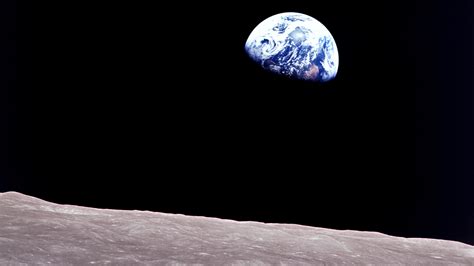
K. And there’s also something kinda funny. We look at the “Earthrise” photo and say that it was taken on Christmas Eve 1968. But, way out there in space, going around the Moon, there is no “eve,” or morning, either. Our notions of time, since the dawn of humankind, have been linked to a very narrow perception of a star seeming to “rise” and “set,” and “move around” the local planet.
E. That’s an interesting point. Quaint and provincial prejudices about time needed to be thrown out the Lunar Module window.
K. Way out there, we see that the Sun isn’t going anywhere. And it’s rather funny to cling to some conceit of time because that’s the way they're viewing it back home in New Jersey.
E. (smiling) You’re right, and this little example of anomaly should alert us to all sorts of coming modifications to our Earthbound mentalities when we cross over to the “real world.”

K. But... Elenchus... do you believe in synchronicities?
E. I guess so... what do you mean?
K. It's very strange... the confluence of the Genesis verse on love and marriage... and then the 1968 Christmas Eve message from the astronauts... I mean ... you remember... what you said about that 1968 Christmas... and us...
E. (sighing)

|
a ‘total field’ perception
In his lectures, Krishnamurti often makes reference to glimpsing the “total field’ of truth.
"I say, you will never find truth through the gradual change of [experience] - only through immediate perception, immediate discernment, lies the whole of wisdom.”
Why is this "immediacy," this "totality" important? Adrian reminded me of the following:
There’s a well known Sufi story from the 12th century about a group of blind people trying to figure out what an elephant is. One person would feel the ear and say it’s like a velvet carpet; another would feel the trunk and say no, it’s a hollow pipe; yet another would feel the leg and say it’s a pillar - but no one has the vantage point to see the whole elephant. The totality of experience is never accessible. In the words of the apostle Paul, “we know in part” (I Cor 13:9). Somewhere there exists a whole elephant, but even the rigorously applied scientific method, the burdens and standards of proof in law and the rules of evidence in court, are limited by human fallibility.
A “total field” perception is important because, even at our best perspicacity, we never see more than a tiny fraction of the Sufi elephant, of reality. This is a problem because the greatest truths cannot be discerned in a piecemeal, gradualistic manner. We need to catch a glimpse of the “total field" -- an “Earthrise perspective.” Mystical experiences offer this, and it’s why they’re so valuable.

Editor's note: As a side issue, we find here the real reason why the so-called perfection available via reincarnation will always disappoint us. There is no coming to truth gradually in 100,000 lives, there is no piecemeal spiritual evolvement - only a momentary cosmic clarity of "total field" can accomplish that.
|
|
Editor’s postscript: After completing the above writing, much of my time was spent finishing both the “Evolution” report and the “Omega” book. As I did, certain elements of “The Wedding Song” enjoyed a much sharper focus. Here’s what I learned.
The universe and the Earth are subject to entropy, a general running down, a tendency toward disorder, of all systems. This is well known in physics. However, Universal Intelligence, at least four times in the last 15 billion years, to effect its goals and purposes, has defied entropy with an injection of complexity and order: these four "creative discontinuities" are:
(1) the coming of matter and energy (“the Big Bang”),
(2) the coming of biological life expressed in numerous body types and new life-forms (“the Cambrian Explosion”),
(3) the coming of sentient life, human beings, and,
(4) the coming of advanced "Omega Point" spiritualized humanity, Twin Souls, reflecting Mother-Father God.
All of these, each in its own time and order, represent "something never seen before." All of these, as bursts of "creative discontinuity," occurred with no prelude, no incremental gradualism, no warning. See the "Evolution" report for much discussion here.
how sane would you like to become: can we say 'this much, no more, I'm fine now, thanks anyway'
“The Wedding Song” focuses on level (4) of this momentous cosmic evolutionary progression. And this is why the Song emphasizes process so much – because there is no end to perfecting human beings in terms of becoming more godlike, more sentient, more sane, with greater joy, love, peace, and happiness.
Yes, how sane would we like to become? - "more tea?" shrieked the Mad Hatter.

oh what is the hatter with you
The "life" that Twins offer each other, that is, draw from each other's sacred inner being, represents our Omega-Point destiny, living on the "level of the gods," Universal Intelligence's grand "creative discontinuity."
(4) It's a final-stage "life," reserved for advanced beings who begin to reflect ultimate reality, the unlimited mind and loving nature of the "Mother-Father" Creator. There's no end to this.
|
|
Editor's last word:
On the "quantum mechanics" page we learned of the work of Dr. David Bohm with his emphasis on "process," which mirrors the essential message of TWS.
Dr. Basil Hiley: “For Bohm, process is the concrete reality of things.” A process of becoming, of connections, relations, as opposed to static eternal particles as hard little "billiard balls."
|
Editor's note: I discovered the following article some time after completing the above writing. It also references the concept of "earthrise" perspective.
|
Reprinted from Beshara Magazine
Jane Clark contemplates the view of Earth from the moon, first captured in the famous photograph ‘Earthrise’
Fred Hoyle, the British astronomer, said: “Once a photograph of the earth, taken from outside, is available, a new idea as powerful as any in history will be let loose.” Twenty years later, such a photograph was taken by the Apollo 8 mission. Jane Clark assesses the impact it has had upon our understanding of ourselves and the world, looking particularly at the experiences of the 500-plus astronauts who have now viewed our planet from space. In the process, she discovers a new psychological phenomenon – ‘the overview effect’.
This spectacular image of Earth rising on the horizon of the moon was taken on Christmas Eve 1968 by the Apollo 8 space mission. Released by NASA a few days later, it instantly took on iconic status. It was the first picture ever taken of our whole planet from ‘outside’ and has become one of the most powerful symbols of our age.
It is ironic, therefore, that it was a completely unplanned result of the mission. There is even some question about which of the three crew members – Frank Borman, Jim Lovell and Bill Anders – took the shot. Generally, it has been attributed to lunar module pilot Bill Anders on his Hasselblad handheld camera. He has explained:
One of my assignments was to photograph the lunar surface to facilitate the evaluation of potential landing sites. I brought a 250 mm lens to bring that alien terrain into better view. On our fourth orbit, the spacecraft was oriented in a different direction. A startling image captivated the three of us – Earth, 238,900 miles away, ascended above the barren lunar surface.
Compelled by that vision, we scrambled for cameras. I deviated from the rigid NASA flight plan. Every photographic exposure had been determined in advance but I had to capture our view with the long lens on color film. [1]
Recordings of the mission reveal that the first image was actually taken in black and white (see video right or below), but it was Anders’ colour version that was eventually chosen by NASA for distribution. The image was doctored before release to increase the dramatic effect. The view seen by the crew was of the Earth to the side of the moon, not above it, and it was tiny – the size of a small marble. NASA changed the orientation so that Earth seemed to be rising above the moon’s horizon, and the area of lunar landscape was then reduced to make it look bigger and hence more important. [2]
But whichever way you look at it, the view is compelling. No one had expected it. The attention of the mission was directed outwards, to the new worlds opening up to human exploration, but the astronauts soon tired of the moon’s surface, which was grey and lifeless. The vision of Earth, by contrast, was riveting. Anders was later to famously remark:
We went to the moon, but what we really discovered was the planet Earth.
The crew of Apollo 8, stepping off the helicopter onto the deck of the US aircraft carrier Yorktown on their return home: William Anders (right), James Lovell (centre) Frank Borman (left). Photograph: NASA
Beauty and Unity
The original power of the image has perhaps diminished over the past fifty years. But viewing Earth from ‘above’ has not lost its attraction for the many astronauts – around 570 to date – who have experienced it first hand. [3] During the first eight missions of the International Space Station, for instance, almost 200,000 photographs of Earth were taken, most of them (over 80%) by crew. And when the members of the Skylab IV crew were denied the time to contemplate it because of excessive workload, they downed tools and rebelled, maintaining that they had “a need to reflect, to observe, to find their place amidst these baffling, fascinating, unprecedented experiences”. [4]
So what is it that is so inspiring about looking back at our planet?
Well, the most obvious answer is that it is beautiful: bright, colourful and palpably alive against the black backdrop of seemingly infinite space. Edgar Mitchell, an astronaut on the Apollo 14 mission (1971), and the sixth person to walk on the surface of the moon, describes it like this:
Suddenly, from behind the rim of the moon, in long, slow-motion moments of immense majesty, there emerges a sparkling blue and white jewel, a light, delicate, sky-blue sphere laced with slowly swirling veils of white, rising gradually like a small pearl in a thick sea of black mystery. It takes more than a moment to fully realize this is Earth… home. [5, page 138]
whilst James Irwin on Apollo 15 (1972) tells us:
The Earth reminded us of a Christmas tree ornament hanging in the blackness of space. As we got further and further away, it diminished in size. Finally it shrank to the size of a marble, the most beautiful marble you can imagine. That beautiful, warm living object looked so fragile, so delicate, that if you touched it with a finger it would start to crumble. Seeing this has to change a man. [5, page 38]
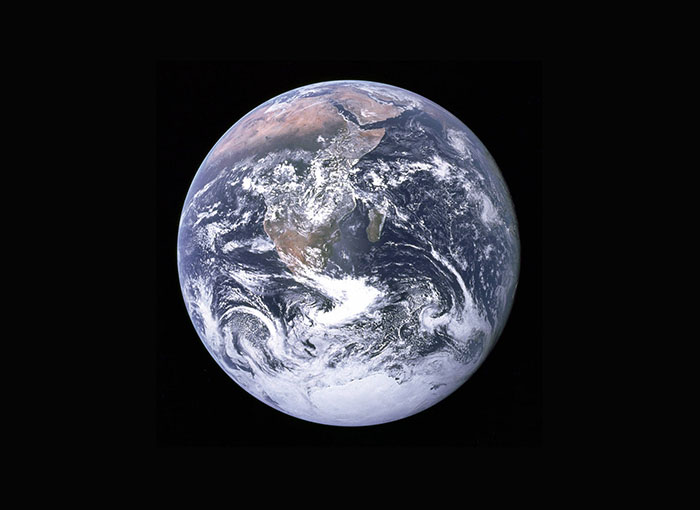
The Blue Marble. View of the Earth as seen by the Apollo 17 crew travelling toward the moon in 1972. This translunar coast photograph extends from the Mediterranean Sea area to Antarctica. It was the first time the Apollo trajectory made it possible to photograph the South polar ice cap. Photograph: Astronaut photograph, courtesy of NASA Johnson Space Center Gateway to Astronaut Photography of Earth [/]
But it is not just aesthetic beauty which seems to have effect. Both Irwin and Mitchell underwent a religious-type experience when they looked down on their home planet; Irwin experienced a rekindling of his Christian belief, but for Mitchell (who went on to found the Institute of Noetic Sciences [/]), it was a moment of conversion:
When I went to the moon I was a pragmatic test pilot. But when I saw the planet Earth floating in the vastness of space, the presence of divinity became almost palpable and I knew that life in the universe was not just an accident. […] On the return trip home, gazing through 240,000 miles of space toward the stars and the planet from which I had come, I suddenly experienced the universe as intelligent, loving, harmonious. [5, page 138]
Most other astronauts express themselves in much more secular terms, but it is clear that they have nevertheless experienced profound changes. They talk, for instance, about a new awareness of the oneness of the Earth and its people. This is from Sultan bin Salman al-Saud (Discovery 5, 1985):
The first day or so we all pointed to our countries. The third or fourth day we were pointing to our continents. By the fifth day, we were aware only of one earth. [5, page 82]
Similarly, the Syrian astronaut Muhammad Faris (Soyus TM-3, 1987) describes how:
From space I saw Earth – indescribably beautiful with the scars of national boundaries gone. [5, page 77]
Yuri Artyukhin, a Russian astronaut who flew on the Soyuz 14 mission in 1974, takes the matter even further:
That feeling of unity is not just simply an observation. With it comes a strong sense of compassion and concern for the state of our planet and the effect that humans are having on it. It isn’t important in which sea or lake you observe a slick of pollution, or in the forests of which country a fire breaks out, or on which continent a hurricane arises. You are standing guard over the whole of our earth. [5, page 71]

Hurricane Florence as seen from the International Space Station. A high-definition video camera outside the space station captured images as Florence, a Category 4 storm at the time, crossed the Atlantic with winds of 130 miles per hour. Photograph: NASA, 11 September 2018
This sense of specialness and vulnerability is a common theme of astronaut comments. Michael Collins, the third man on Apollo 11, the moon landing expedition which happened less than a year after Apollo 8, has confessed that:
The thing that really surprised me was that it [Earth] projected an air of fragility. Why, I don’t know. I don’t know to this day. I had a feeling it’s tiny, it’s shiny, it’s beautiful, it’s home, and it’s fragile. [6]
while Taylor Wang, the Chinese–American astronaut who flew on Challenger 7 (1985), develops a beautiful analogy:
They say, if you have experiments to run, stay away from the window… it was not until the last day of the flight that I even had a chance to look out. But when I did, I was truly overwhelmed. A Chinese tale tells of some men sent to harm a young girl who, upon seeing her beauty, become her protectors rather than her violators. That’s how I felt seeing Earth for the first time. “I could not help but love and cherish her”. [5, page 60]
The awakening of tenderness and protectiveness has brought about the most evident effect of ‘Earthrise’ to date at a cultural level. In 1968, people were still absorbing Rachel Carson’s seminal work Silent Spring, which revealed for the first time the damaging effect of pesticides upon the ecosystem (see our previous article). The image of the earth as a living, fragile entity, alone in the vastness of space, was catalytic...
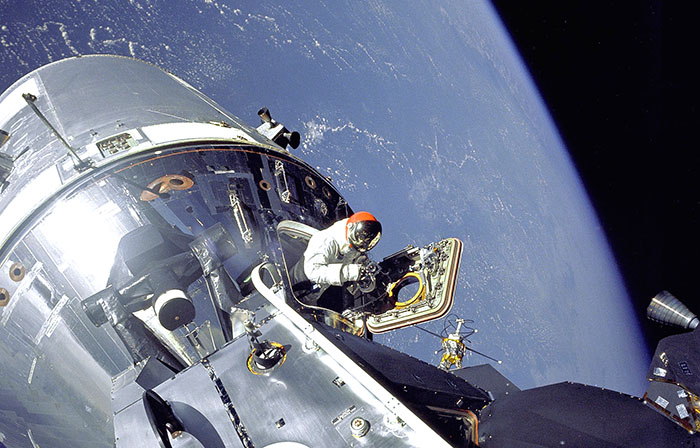
Apollo 9: Commander module pilot David Scott’s extravehicular activity (EVA) on the fourth day of their mission. This photograph was taken by Russell Schweickart, lunar module pilot, from the porch of the module. Inside was astronaut James A. McDivitt. Photograph: NASA, 3 June 1969
The Overview Effect
An abrupt change of perspective has been so commonly experienced by astronauts that it is now recognised as new psychological phenomenon, ‘The Overview Effect’ (see video right or below for an extended exposition). The term was first coined by Frank White in his 1987 book of the same name [8] and it has since become a subject of serious study, not least because as we start to think about longer space journeys to Mars and beyond, it is a strong positive in a situation where there are many negatives – fear, loneliness, stress, dealing with weightlessness and cramped living spaces over long periods of time, interpersonal problems, etc. By contrast, the overview effect produces a sense of well-being and fulfilment, which in turn has measurable benefits for both the mind and the cardiovascular system.
One of its main features has been identified by researchers as ‘awe’. This is defined as “the intense emotion resulting from the perception of something vast”, bringing about feelings of “wonder, reverence, humility and unity”. [4] The awe experienced by astronauts differs from the feeling we might experience when viewing the vastness of any earthly feature – even the greatness of the Grand Canyon or the Himalayas – because it also includes a sense of totality; seeing things as whole, whether that be the earth, the ecosystem, humankind or the universe itself. It is, as Edgar Mitchell has put it “instant global consciousness”. This experience in itself changes people, and like the crew of Skylab IV, they need time to absorb it.
But for some people, there is even more. The overview effect can trigger what psychologists now call ‘self-transcendent experiences’ in which people undergo a temporary change of identity – a release from the individual self – leading to a sense of deep connection with others. These experiences are likened by researchers to states of spiritual transformation – “which” they remind us, “have historically been associated with practices such as prayer, meditation, and religious rituals as well as the use of psychedelic drugs”. [4] One of the most striking examples of such an experience is recounted by astronaut Russell Schweickart, a crew member on the Apollo 9 mission (1969):
I had five minutes when I was outside on the EVA [extravehicular activity] because of a camera failure and I had nothing to do. I decided that I was going to be just a human being for those five minutes and not an astronaut. So I spent the time just looking at this incredible scene, and one of the many questions that came up was: What does it mean when I say ‘I’? Am I just me, or – looking at life and the earth – am I ‘us’? [9]
In Kevin Kelley’s beautiful book The Home Planet, [5] from which many quotes in this article have been taken, he talks further about what he means by this sense of ‘us’:
You look down and see the surface of that globe that you’ve lived on all this time, and you know all those people down there, and they are like you, they are you, and somehow you represent them. You are up there as a sensing element, that point out on the end, and that’s a humbling feeling. It’s a feeling that says you have a responsibility. It’s not for yourself. The eye that does not see does not do justice to the body. That’s why it’s there; that’s why you are out there. And somehow you recognize that you are part of that total life…
And when you come back, there is a difference in the world now. There’s a difference in the relationship between you and the planet and … all those other forms of life on that planet. [5, page 144]

The International Space Station (ISS). Astronauts Robert Curbeam (USA) and Christer Fuglesang (Sweden) work to attach a new truss segment. The station is so large that it could not be launched all at once, and so was built piecemeal, with large sections added continually by flights of the space shuttle. Photograph: STS-116 crew, NASA. Astrology Picture of the Day (APOD) 25 December 2006
Contemporary Experiences
The early astronauts spent relatively little time in space, with most of the Apollo missions lasting just a few days. Since then, with the establishment of space stations, it has become common for people to remain for much longer periods in the earth’s orbit. The current record-holder is Russian astronaut Valeri Polyakov, who spent 437 continuous days on Soyuz TM-18/20 in 1994/5, whilst Gennadi Podolka has clocked up a total of 878 days – two and a half years – over six stints. [3]
But familiarity does not seem, in this case, to lessen the effect – on the contrary. In a recent TV series One Strange Rock [10], which documents contemporary developments in space, Chris Hadfield, the Canadian astronaut who served as commander of the ISS, recounts:
One of the biggest changes I found in myself as a result of flying in space was that the difference between ‘us’ and ‘them’ disappears. Somehow going round the world in 92 minutes not just once but over and over again, turned the entire world into one shared place. I think it is a perspective that seeps into astronauts. I think it’s a perspective that’s kinda good for everybody. [10]
In the same series, the American astronaut Peggy Whitson, who spent a total of 666 days in space before her retirement in 2017, explains:
As I’ve grown up and gone to college and gone to graduate school, home has expanded from Iowa to Texas to the United States. But since being in space, home is actually planet Earth. [10]
And in a vivid description of the sudden transition in consciousness which is the essence of the overview effect, she goes on:
The first thing we want to do [when we go into space] is check out the view. Going into space is like I lived my whole life in a semi-dark room, and [then] somebody flipped on the lights. [10]
What is more, the experience seems to produce lasting changes, increasing people’s sense of unity with others and their altruistic tendencies when they return home. As Boris Volynov said after his flights on Soyuz 5 and 21 (1969 and 1976):
During space flight, the psyche of each astronaut is reshaped. Having seen the sun, the stars, and our planet, you become more full of life, softer. You begin to look at all living things with greater trepidation and you begin to be more kind and patient with the people around you. At any rate, that is what happened to me. [5, page 88]
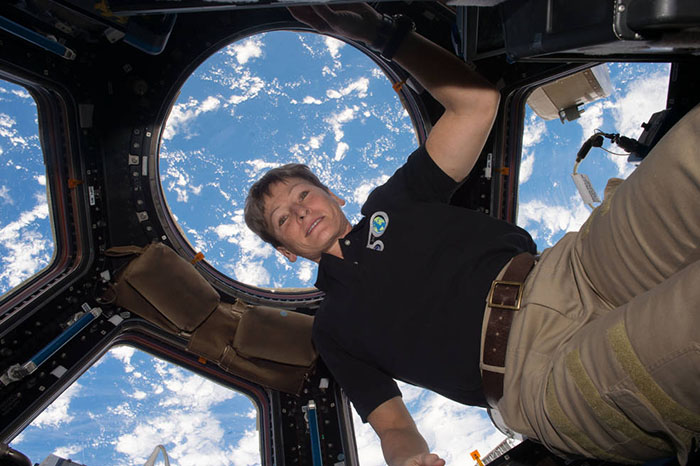
Peggy Whitson, the American astronaut who was has spent 666 days in space, in front of the Cupola windows of the International Space Station. Photograph: NASA, 18 July 2017
Reflections
There is no doubt that there are enormous contradictions in the space programme. Whatever might be said about “one giant step for mankind”, the Apollo missions were strongly motivated by cold war rivalry with Russia; one of the main tasks assigned to Armstrong and Aldrin was to plant an American flag on the moon. Once the race was won, political interest waned and NASA funding was dramatically cut. Nowadays, exploration of the moon – and indeed many aspects of space travel – is largely left to commercial interests, either for tourism or exploitation of resources.
Similarly, no one following the recent coverage of the first moon landing could fail to see how the event, watched at the time by an audience of over 600 million worldwide, touched people and brought them together. But fifty years on it is hard to perceive any lasting result of this shared moment of unity. We seem to be as divided as we have ever been.
One of the problems, perhaps, is that the psychologists tell us that in order to really experience the overview effect, you have be there yourself, in person, looking down upon the earth. Contemplating an image is not the same. This means that even if people like Elon Musk were to succeed in establishing space tourism, the vast majority of us will never have the first-hand experience, and so never truly undergo the change of perspective that the overview seems to catalyse.
But having spent the last weeks looking at picture after picture of Earth from space, every one of them testifying to the almost unbelievable beauty and preciousness of our planet, I find it hard to believe that these images do not have a profound effect. Even at second hand, the perspective – to paraphrase Chris Hadfield – “seeps into us”. The British astronomer Fred Hoyle, writing in 1948, maintained that:
Once a photograph of the Earth, taken from outside, is available, once the sheer isolation of the Earth becomes known, a new idea as powerful as any in history will be let loose.
He was surely right, even if the full impact of this new idea has not yet been felt.
But in a way, it is not new. As researchers into the overview effect have noted, the idea of unity – one earth, one people, one ‘I’ and even, in the end, one reality – has been a foundational principle of the spiritual/mystical traditions throughout the ages, and it has been realised and lived by people of wisdom. All that has changed now is the mode in which we know it – as a physical reality as well as in the imagination. From this point of view, these brave astronauts are simply bearing witness – acting, as Rusty Schweickart puts it, as our “sensing element”, our “eye” – to a truth which is already deeply embedded in our psyche. Rakesh Sharma, the Indian astronaut who served on Soyuz T-11, describes the situation like this:
My mental boundaries expanded when I viewed the Earth against a black and uninviting background, yet my country’s rich traditions had conditioned me to look beyond man-made boundaries and prejudices. One does not have to undertake a space flight to come by this feeling. [5, page 80]
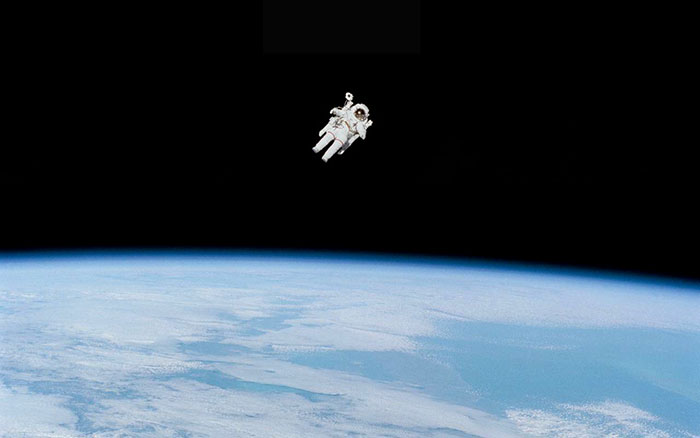
Astronaut Bruce McCandless photographed during the first of his two space shuttle missions. He went ‘free-flying’ to a distance of 320 feet away from the shuttle, using a jet pack called the Manned Maneuvering Unit, or MMU. He and his colleague Robert Stewart were photographed by fellow crew-members in Challenger’s cabin. Photograph: NASA, 2 November 1984
And looking the other way… We should not forget that astronauts sit between two wonderful views; on the one hand, they look back upon their home planet, and on the other they look out into the vastness of space. Since the 1960s, we have added many additonal ‘eyes’ to our preception of the universe through international projects such as the Hubble Telescope and probes into the outer reaches of the solar system. Every day, NASA makes available a new wonder from this exploration as Astronomy Picture of the Day (APOD). The picture below was the APOD for 2nd August 2019 when this article was published; you can see the current picture by clicking on the button below.
Chamaelean II dark nebula, about 500 light years from Earth. Photograph: Dan Goldman/NASA
|
|
